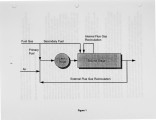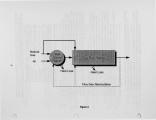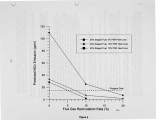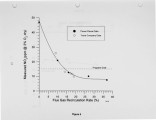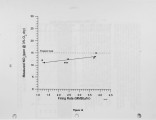| OCR Text |
Show 20% flue gas recirculation. The PSR residence time was set to be 30 IDS. This time was selected based on the expected size of the recirculation zone in the burner flowfield. In both cases, the predicted NOx levels are dramatically lower at lean combustion conditions. Typical output plots from the complete PSRlPFR chemical kinetics modelling computations are shown in Figures 4 and 5. The output is in the fonn of temperature and species concentrations as a function of axial position (and hence residence time) in the simulated chiller combustion chamber. In Figures 4 and 5, the predicted temperature and NOx concentration at the exit from the PSR stage are also shown. In all cases, the PSR residence time was 30 IDS. Figure 4 shows results for a simulation of an uncontrolled burner, i.e. a burner with no fuel staging, no flue gas recirculation, no air staging and no heat loss from the PSR stage. Flame tem~ratures are relatively high and the predicted NOx emissions are of order 100 ppm. Figure 5 shows the predictions for an optimized burner design: 20 percent staged fuel, 20 percent flue gas recirculation (to the PSR), and 10 percent heat loss from the PSR. The flame temperatures are moderated considerably without compromising stability or CO burnout, and the predicted NOx emissions are less than 10 ppm. The relative importance of the key burner operating parameters on NOx formation is discussed below. Effect of Flue Gas Recirculation. Figure 6 shows the effect of flue gas recirculation on predicted NOx emissions for several burner configurations. The dramatic effect of a small amount of flue gas recirculation on NOx emissions is particularly apparent for the limiting and worst case of having no heat loss from the first (or PSR) stage. However, even in this case, approximately 20 percent flue gas recirculation is predicted to result in attainment of very low NOx levels. For the more realistic case of 10 percent heat loss from the fIrst stage, about 10 percent flue gas recirculation represents an attractive level, since at this point most of the NOx reduction benefits have been realized. Effect of Fuel Staging. With other parameters fixed, increasing the staged fuel from 20 to 40% of the total results in a modest decrease in predicted NOx levels. As fuel is shifted to the second stage, less NOx forms in the first stage, but more forms in the second stage. Effect of Heat Loss from First Stage. With no flue gas recirculation, first stage heat loss has a significant impact on predicted NOx levels and heat loss in excess of 10 percent is needed to achieve low NOx levels. With 20 percent flue gas recirculation, very low NOx levels are achieved and the fIrst stage heat loss has little impact. 2 The kinetic modelling was used as a tool to guide the optimization of burner design and operating conditions. The absolute NOx levels predicted are not meant to represent expected emission levels. More significance is placed in the trends in predicted emission levels as operating parameters are varied. 8 |



